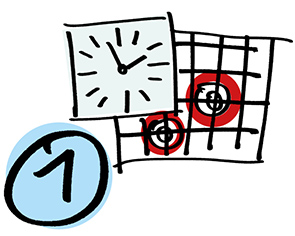1. Spatial and Temporal Coherence
To create a cooperative UAV swarm capable of joint radar operation and imaging, a coherent multistatic radar network must be established. Therefore the KoRaTo project will explore and compare different radar, radiolocation, and synchronization approaches to establish spatial and temporal coherence between radar sensors mounted independently on different robots or UAVs. In addition, radar network system concepts are being researched and developed aiming at multi-static radar networks with both active and passive (repeater) radar sub-apertures carried by the independent UAVs.
Compared to monostatic measurements, in a multi-static setup different viewing angles of the same scene are available at the same time promising improved imaging performance regarding for instance clutter suppression or object detection by measuring angle-dependent reflective properties of the environment. At the same time, measurement time may be reduced by using multiple radar nodes at the same time. However, realizing a multi-static network that allows to merge multiple measurements into a common radar image requires coherent measurements. Because the radar sub-apertures are carried by independent UAVs and have independent signal sources, they are neither spatially nor temporally coherent. However, spatial and temporal coherence is a key requirement and yet unresolved issue for cooperative aperture synthesis and high-resolution imaging. In order to establish such coherence, high-precision spatial localization of the sub-apertures as well as phase-synchronous operation of all radars is needed. In KoRaTo novel methods for 6D radiolocation of mobile radars and ultra precise synchronization of distributed clock sources are therefore being researched.

Sub-Projects
Phase coherent wireless localization networks
Lead: Prof. Dr.-Ing. Martin Vossiek, Institute of Microwaves and Photonics, FAU
This subproject focuses on phase-coherent radiolocation networks, which are intended to serve as a central aspect of the KoRaTo idea for establishing spatial and temporal coherence as well as phase coherence of the distributed radar sensors installed on the swarm participants.
In the field of communication and wireless locating techniques, there are many approaches to locate and synchronize distributed network nodes. However, the nodes of almost all previous solutions operate non-coherently. The synchronization in the picosecond range (clock offset) or in the sub-ppb range (clock rate) necessary for carrier phase coherency, and a localization accuracy with sub-carrier-wavelength precision, which would be required for a multistatic radar aperture synthesis, has not yet been demonstrated, especially not in radar networks of small, mobile swarm participants.
The starting point of the work is the CFDDS-TWR method, which is to be extended to multistatic networks. For the development and optimization of phase coherent synchronization methods in a multistatic wireless locating network, a simulation environment as well as a 24GHz laboratory demonstrator will be realized. A further task is to develop a localization algorithm which determines the 6D UAV swarm constellation during the SAR image recording. Therefore, the exchanged RF signals, the obtained ranging as well as phase information and IMU data will be fused by a holographic aperture synthesis algorithm. An important research aspect of the work is the assessment of the achievable localization accuracy by evaluating the determined stability and synchronization quality of the local time bases and by evaluating the temporal and stochastic parameters of recorded signals.
Multistatic radar networks for UAV-based SAR using radar repeater networks
Lead: Prof. Dr.-Ing. Christian Waldschmidt, Institute of Microwave Engineering, UUlm
Both conventional radar sensors and repeater units work together to form a multistatic network for remote sensing on UAVs. The repeater units receive the signal transmitted by the radar sensors and reflected on the ground and return it to them. To be able to distinguish monostatic and bistatic signals, the signal is modulated by the repeater. This allows coherent measurements in both range and Doppler directions.
These approaches will be extended in KoRaTo by GPSAR methods that use the motion of the UAV, so that SAR images can be generated multistatically from the radar repeater unit. A major advantage of this approach is that all multistatic data can be processed together at the radar sensor, although different viewing angles are used.
Essential for the use of the repeater units is the conceptual design for the temporal synchronization of the sensors and repeaters, so that an assignment of the signals to the correct node is possible. The mono- and bistatic images should then be combined into a coherent multilook image. The work of this subproject will enable the generation of initial multistatic datasets that will be used in various other subprojects.
